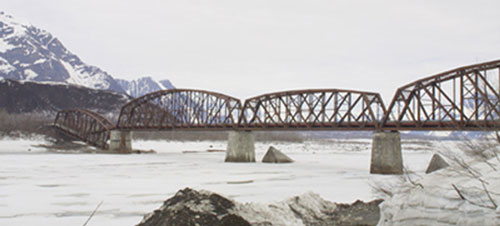Glaciers no obstacle for Copper River and Northwestern Railway
By Ned Rozell
Completed in 1910, the Million Dollar Bridge was the crux of the Copper River and Northwestern Railway, built to carry copper ore 196 miles from Kennicott to Cordova. Along that route were some of the greatest obstacles Alaska offers—steep canyons, rivers, hurricane-force winds, mosquitoes, and dozens of glaciers.

The Million Dollar Bridge, built for $1.4 million and completed in 1910, was the largest construction challenge of the Copper River and Northwestern Railway. The northern span fell in 1964 during the Good Friday Earthquake. Photo by Ned Rozell.
Glaciers stuck out their tongues in defiance along the entire route, but the pull of financial gain and human ingenuity overcame them. In one case, workers laid tracks across the debris-covered ice of Allen Glacier for five-and-one-half miles, according to my two sources for this column: the books, The Copper Spike by Lone E. Janson, and Iron Rails to Alaskan Copper, by Alfred Quinn.
Two of the largest obstacles on the route were Miles and Childs glaciers, both of which calve icebergs into the Copper River from opposite banks. Erastus Hawkins, the engineer in charge of the railroad project, and Michael Heney, the construction contractor, preferred to run the railroad alongside the Copper River, but the Miles and Childs glaciers sprawl over both shorelines at a pinch-point about 15 miles from the river’s mouth. Not listening to other engineers who thought the problem was insurmountable, Hawkins designed a 1,550-foot steel bridge to span the Copper River at a river bend between the two glaciers.

Copper River Delta picture By Dennis Zaki
Starting in April 1909, workers scrambled to complete the Million Dollar Bridge, spurred on by a U.S. law that gave railroad developers four years to complete a designated route. After four years, the government would tax them $100 per operating mile per year. Contractors finished the bridge by midsummer of 1910.
Soon after construction of the Million Dollar Bridge (which cost $1.4 million to build), the glaciers continued to threaten the railroad.
In August 1910, two glaciologists from the National Geographic Society studied the sudden advances of both Miles and Childs glaciers. A northern lobe of Childs Glacier began creeping toward the bridge in June, and by August it was moving eight feet per day. On August 17th, the 200-foot face of the glacier was 1,624 feet away from the bridge.
Ralph Tarr, one of the glaciologists, speculated on what would happen if the glacier continued to advance in 1911.
“It is absolutely certain that no corps of engineers could save the bridge and railway if the glacier should advance that far,” he wrote.
Childs Glacier did not engulf the bridge, but the glacier crept to within 1,475 feet in June 1911. Childs and Miles glaciers have since retreated, sparing the Million Dollar Bridge, which served the railway from 1910 until 1938, when low copper prices forced the shutdown of the Copper River and Northwestern Railway. The bridge survived nature’s whims until March 27, 1964, when the Good Friday Earthquake knocked the northernmost span from its concrete piling.
First published October 3, 2007
Since the late 1970s, the director of the Geophysical Institute at the University of Alaska Fairbanks has supported the writing and free distribution of this column to news media outlets. This is Ned Rozell’s 20th year as a science writer for the Geophysical Institute.
